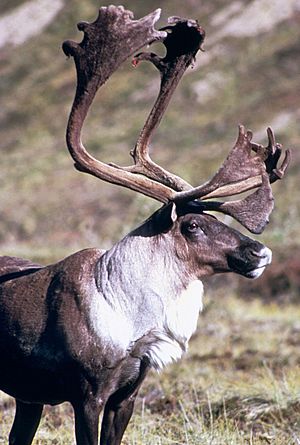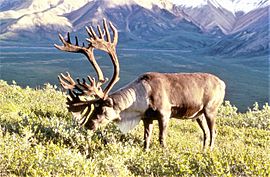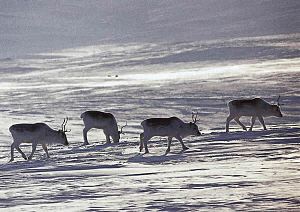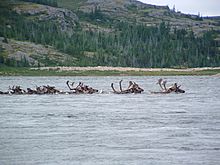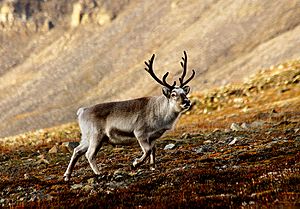Reindeer distribution facts for kids

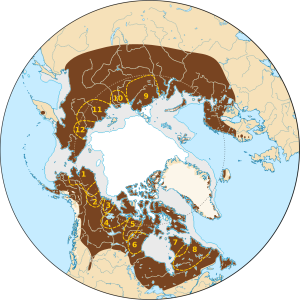
The reindeer is a type of deer found across the northern parts of the world, including tundra (treeless plains) and taiga (boreal forests). These animals are also known as caribou in North America. They once lived in many places like Scandinavia, eastern Europe, Russia, Mongolia, and northern China. In North America, they were found in Canada, Alaska (part of the United States), and even parts of the northern USA.
Sadly, wild reindeer have disappeared from many of these areas, especially in the south. Today, you can still find wild reindeer in Norway, Finland, Siberia, Greenland, Alaska, and Canada. Some reindeer are also domesticated, meaning they are raised by people. These semi-domesticated reindeer are mostly found in northern Europe and Russia.
Reindeer and caribou numbers have changed a lot over time. Many herds are now shrinking. This decline is often linked to climate change for herds that migrate long distances. For herds that stay in one place, it's often due to human activities that disturb their homes.
Contents
Reindeer in Russia
In 2013, the Taimyr herd in Russia was the biggest reindeer herd in the world. Its population grew to 1,000,000 in 2000. However, by 2009, it had dropped to 700,000 animals. Back in the 1950s, there were only 110,000.
There are three large herds of wild reindeer in central Siberia's Yakutia region. These are the Lena-Olenek, Yana-Indigirka, and Sundrun herds. The Lena-Olenek herd's population is stable. But the other two are getting smaller.
Further east, the Chukotka herd is also shrinking. In 1971, there were 587,000 animals. Their numbers fell sharply in 1986 to just 32,200. They recovered for a while, but by 2009, there were fewer than 70,000.
Caribou in North America
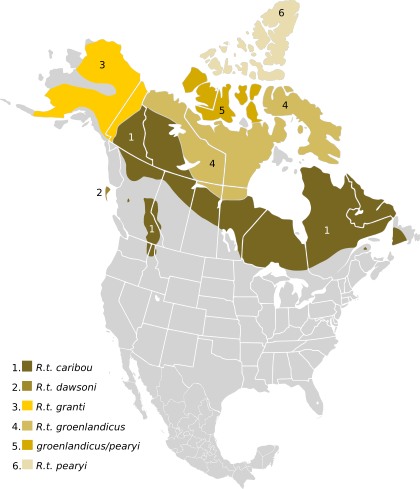
In North America, reindeer are called caribou. There are four main types, or subspecies, of caribou. These include the woodland caribou (R. t. caribou), Porcupine caribou (R. t. granti), barren-ground caribou (R. t. groenlandicus), and Peary caribou (R. t. pearyi).
Woodland caribou live in many different environments. They are further divided into groups based on their behavior. Some are boreal (forest-dwelling), some are migratory (they move long distances), and some live in mountains.
Caribou are considered endangered in some parts of Canada. This includes areas in British Columbia. They were also endangered in Idaho and Washington in the United States. The Peary caribou is on the endangered list worldwide.
Caribou in the United States
Most caribou populations in the U.S. are found in Alaska. There was a small group of about a dozen woodland caribou in the Selkirk Mountains of Idaho. These were the last wild caribou in the lower 48 states. In 2021, the last female was moved to Canada. This means wild caribou are no longer found in the contiguous United States.
Caribou Herds in Alaska
There are four main caribou herds in Alaska. These are the Western Arctic herd, the Teshekpuk Lake herd, the Central Arctic herd, and the Porcupine herd. The Porcupine herd is special because it crosses borders into Canada.
The Western Arctic caribou herd is the largest. The Porcupine herd is smaller, but it has the longest migration of any land mammal on Earth. Its historical range is very large.
The Porcupine Caribou Herd
The Porcupine caribou herd travels long distances between countries. It is named after the Porcupine River, which flows through much of its home range. In the past, some caribou herds had over a million animals. It could take more than ten days for them to cross the Yukon River. However, these numbers have dropped due to changes in their habitat.
In July 2010, the Porcupine herd had about 169,000 animals. Their yearly migrations cover about 1,500 miles (2,400 km). This is one of the longest migrations for any land mammal. Their range covers about 100,000 square miles (260,000 km²). It stretches from Aklavik, Northwest Territories to Dawson City, Yukon and to Kaktovik, Alaska.
The Porcupine caribou is managed by both U.S. and Canadian governments. This is because their range covers both countries. The Gwich'in people have followed this herd for thousands of years. It was their main source of food, tools, and clothing. Other groups like the Inupiat and Inuvialuit also rely on this herd for food.
There is some debate about future oil drilling in the Arctic National Wildlife Refuge. This area includes much of the Porcupine caribou's birthing grounds. Some worry it could harm the caribou population.
Unlike many other caribou types, the Porcupine caribou herd is stable and has high numbers. In 1989, it reached a peak of 178,000 animals. It then dropped to 123,000 by 2001. But by 2010, it had recovered to 169,000 animals. Many Gwich'in people still follow traditional rules for managing the caribou. This includes not selling caribou meat and limiting how many can be hunted.
The Western Arctic Caribou Herd (WACH)
The Western Arctic caribou herd is the largest of the Alaskan herds. In the mid-1970s, its numbers were low, with only 75,000 animals. In 1997, the herd changed its migration path. It spent the winter on the Seward Peninsula.
Reindeer herding in Alaska started on the Seward Peninsula in 1892. Reindeer were brought from Siberia to provide food for local people. For many years, it was thought that wild caribou and domesticated reindeer would not mix. However, in 1997, some domesticated reindeer joined the Western Arctic caribou herd and disappeared. The WACH reached a peak of 490,000 in 2003. By 2011, it had declined to 325,000.
Teshekpuk Lake and Central Arctic Caribou Herds
In 2008, the Teshekpuk Lake caribou herd had 64,107 animals. The Central Arctic caribou herd had 67,000.
By 2017, the Teshekpuk herd's numbers had dropped to 41,000 animals. Their birthing grounds are near the shallow Teshekpuk Lake. This lake is in the traditional lands of the Iñupiat, who have depended on this herd for thousands of years.
Teshekpuk Lake is also part of the National Petroleum Reserve-Alaska (NPR-A). This is a huge area of public land. In 2006, the U.S. Department of the Interior approved oil and gas drilling there. The Iñupiat people and others protested this decision. In September 2006, a court protected the wildlife habitat around the lake from oil and gas leases.
However, in October 2017, new plans for oil and gas leasing were announced. These plans would allow drilling in sensitive areas. This includes the Teshekpuk caribou herd's birthing grounds. The caribou stay in these grounds for several weeks in spring. They then move away from Teshekpuk Lake to escape mosquitoes and botflies before their yearly migration.
Reindeer Imported to Alaska
Reindeer were brought to Alaska from Siberia in the late 1800s. More came from Norway in the early 1900s. These were semi-domesticated animals. Reindeer can breed with native caribou subspecies.
Caribou in Canada
The barren-ground caribou (R. t. groenlandicus) travels long distances. Large herds of this type live in the Northwest Territories and Nunavut. Examples include the Beverly, Ahiak, and Qamanirjuaq herds. In 1996, the Ahiak herd had about 250,000 animals.
Ahiak, Beverly and Qamanirjuaq Caribou Herds
The Ahiak, Beverly, and Qamanirjuaq caribou herds are all barren-ground caribou.
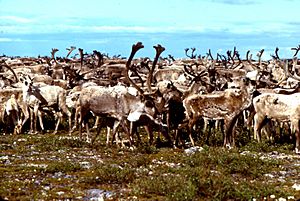
The Beverly herd's crossing of the Thelon River was important to the Dene people for 8,000 years. This is shown by old caribou bones and tools found along the river. The Beverly and Qamanirjuaq Herds are managed by a special board.
The Beverly herd's population peaked in 1994 with about 276,000 to 294,000 caribou. But by 2011, there were only about 124,000 caribou in the Beverly herd. The Ahiak herd had 83,300. Caribou management groups are worried about habitat loss and disturbance. They also worry about parasites, predators, and bad weather. These factors are causing most caribou populations to shrink.
The barren-ground caribou population on Southampton Island, Nunavut, dropped by almost 75%. It went from about 30,000 caribou in 1997 to 7,800 in 2011.
Peary Caribou on Baffin Island
The Peary caribou (R. t. pearyi) is the smallest caribou in North America. It is called tuktu by the Inuktitut people. These caribou live on the northern islands of Nunavut and the Northwest Territories. Their numbers remain low after big declines.
On Baffin Island, the Peary caribou population was very high in the early 1990s. It ranged from 60,000 to 180,000. By 2012, numbers in northern Baffin Island were low. In southern Baffin Island, the population was estimated between 1,065 and 2,067.
Caribou in the Northwest Territories
There are four barren-ground caribou herds in the Northwest Territories. These are the Cape Bathurst, Bluenose West, Bluenose East, and Bathurst herds. The Bluenose East caribou herd started to recover. Its population was about 122,000 in 2010. This recovery is believed to be due to the creation of Tuktut Nogait National Park. However, the other three herds have dropped by 84–93% from their highest numbers in the 1980s and 1990s.
Woodland Caribou (R. t. caribou)
The woodland caribou (R. t. caribou) is divided into three types based on their behavior. These are boreal (forest-dwelling), migratory, and mountain woodland caribou. Caribou are grouped by where they live, how they spread out, and if they migrate.
In Canada, the boreal woodland caribou lives in the boreal forest. This stretches from the Northwest Territories to Labrador. They like old forests with lots of lichen. They also live in marshes, bogs, and near lakes and rivers.
Historically, the boreal woodland caribou lived in over half of present-day Canada. Their range extended from Alaska to Newfoundland and Labrador. It went as far south as New England, Idaho, and Washington. Woodland caribou have disappeared from most of their original southern range. Only about 34,000 remain. The boreal woodland caribou was listed as threatened in 2002.
The George River Caribou Herd (GRCH)
The migratory George River caribou herd (GRCH) lives in the Ungava region of Quebec and Labrador. This herd was once the largest caribou herd in the world. It had between 800,000 and 900,000 animals.
Even though it's a woodland caribou, the GRCH is migratory. It behaves more like barren-ground caribou. It is not sedentary (staying in one place) like most woodland caribou. Since the mid-1990s, the herd has shrunk greatly. By 2010, it was down to 74,131 animals. This is a drop of up to 92%. A 2011 survey confirmed the decline was continuing. By 2018, it was estimated to be fewer than 9,000 animals.
The Leaf River Caribou Herd (LRCH)
The Leaf River caribou herd (LRCH) is another migratory type of woodland caribou. It lives near the coast of Hudson Bay. This herd grew from 270,000 animals in 1991 to 628,000 in 2001. However, by 2011, the herd had decreased to 430,000.
An international study suggests that the George River and Leaf River herds could face extinction by 2080.
Queen Charlotte Islands Caribou
The Queen Charlotte Islands caribou (R. t. dawsoni) lived on Graham Island. This island is the largest of the Queen Charlotte Islands. This caribou was thought to be a unique subspecies. It became extinct in the early 1900s. However, recent DNA tests suggest that these caribou were not genetically different from mainland Canadian caribou.
Reindeer in Greenland
In 2013, there were four main populations of barren-ground caribou (R. t. groenlandicus) in western Greenland. The Kangerlussuaq-Sisimiut herd was the largest. It had about 98,000 animals in 2007. The second largest, the Akia-Maniitsoq herd, decreased from 46,000 in 2001 to about 17,400 in 2010. One reason for the difference might be how easy it is for hunters to reach them.
Reindeer in Norway
The last wild tundra reindeer in Europe live in parts of southern Norway. In the mountain ranges of southern Norway, there are about 30,000–35,000 reindeer in 23 different groups. The largest herd, with about 10,000 animals, is at Hardangervidda.
By 2013, the biggest problems for managing these reindeer were habitat loss and blocked migration paths. This was due to small construction projects and human activities.
Norway is working to make areas with reindeer hunting history a World Heritage Site. These areas include Dovrefjell-Sunndalsfjella National Park, Reinheimen National Park, and Rondane National Park. Reindeer hunting has been a continuous tradition in these parts of Norway since the Stone Age.
On August 29, 2016, the Norwegian Environment Agency announced that 323 reindeer died from a lightning strike in Hardangervidda. On December 3, 2018, a hiker in Northern Norway saw and photographed a rare white reindeer calf.
Svalbard Reindeer
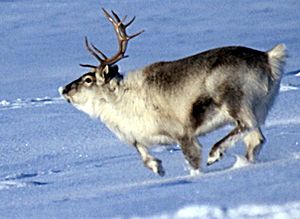
The Svalbard reindeer (R. t. platyrhynchus) lives on Svalbard Island. It is very small compared to other reindeer subspecies. This is a phenomenon called insular dwarfism. Females are about 150 cm (59 inches) long. They weigh around 53 kg (117 lbs) in spring and 70 kg (154 lbs) in autumn. Males are about 160 cm (63 inches) long. They weigh around 65 kg (143 lbs) in spring and 90 kg (198 lbs) in autumn.
The Svalbard reindeer also have relatively short legs. Their shoulder height can be as low as 80 cm (31 inches). This follows Allen's rule, which suggests that animals in cold climates have shorter limbs to conserve heat.
The Svalbard reindeer likely developed from large European reindeer. They are unique in several ways. They have special ways their bodies work. Their skeletons also show unusually short legs. This is similar to many extinct deer species that lived on islands.
Reindeer in Sweden
Reindeer mostly live in the northern parts of Sweden. They are also found in the central Swedish province of Dalarna. In northern Sweden, reindeer herding is often part of the traditional way of life for the Sámi people.
Reindeer in Finland
The Finnish forest reindeer (R. t. fennicus) lives in the wild in only two areas of the Fennoscandia peninsula. These are in Finnish/Russian Karelia and a small group in central south Finland. The Karelia population extends far into Russia.
By 2007, reindeer experts were worried about the decline of the wild Finnish forest reindeer in Kainuu. In 2001, the population in Kainuu was 1,700. But in a helicopter count in March 2007, only 960 individuals were found.
Reindeer in Iceland
East Iceland has a small herd of about 2,500–3,000 animals. Reindeer were brought to Iceland in the late 1700s. In July 2013, the Icelandic reindeer population was estimated at about 6,000.
Reindeer in the United Kingdom
Semi-domesticated reindeer were brought to Scotland in 1952. In 2017, there were about 150 left. They graze across 10,000 acres of land in the Cairngorms National Park. The climate there is similar to tundra.
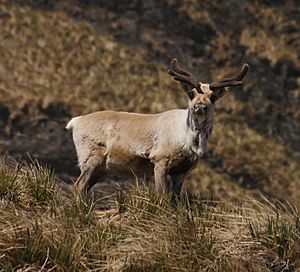
A few reindeer from Norway were brought to the South Atlantic island of South Georgia in the early 1900s. The South Georgian reindeer totaled about 2,600 animals. They lived in two separate herds, divided by glaciers.
The flag and coat of arms of the territory even show a reindeer. However, in 2011, a decision was made to remove all the reindeer from the island. This was because they were causing environmental damage. A team of Norwegian Sámi hunters carried out the removal from 2013 to 2017. This process revealed the true count was around 6,750 reindeer.
Reindeer in French Overseas Territory
About 4,000 reindeer have been introduced to the French sub-Antarctic islands of the Kerguelen Islands.


